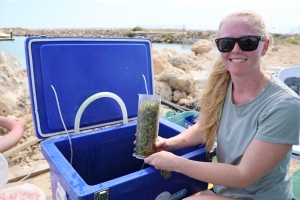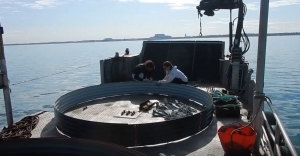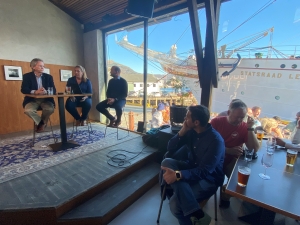Volunteers spring into action to help seagrass recovery in Cockburn Sound
A seagrass restoration program, that is helping to regenerate Cockburn Sound’s underwater meadows, has had a record number of volunteers helping to spread hundreds of thousands of seeds from the plants.
About 80 per cent of Cockburn Sound’s meadows were wiped out in the 1950s and 60s because of poor water quality. Seeds for Snapper harnesses community help, backed by scientific knowledge, to collect seagrass seeds and disperse them where they are most needed.
Research officer Rachel Austin, from The University of Western Australia’s School of Biological Sciences, who helps run Seeds for Snapper with fishing conservation charity OzFish, said volunteers helped disperse 670,000 seeds over 10 sites during November. They donated 1500 hours.
“It’s very simple, very scalable and results in much higher seeding density than what happens naturally,” Ms Austin said.
“We estimate that more than 90 percent of seagrass fruit ends up where it cannot grow, including on the beach and in deep water.
“We are able to collect the seeds and throw them into specially chosen areas where they are more likely to take hold.”

Rachel Austin from UWA with seagrass seeds at a volunteers’ day in Cockburn Sound.
“By doing what we are doing we can get substantially more seedlings in an area compared to what can happen naturally.”
She said the program had not only had a practical benefit in helping regenerate parts of the seabed but had also increased awareness of the importance of seagrass for storing carbon, stabilising the seabed and providing breeding areas and habitat for marine animals.
“If you want squid, fish and octopus you’ve got to have somewhere for them to live and that is your seagrass meadows,” Ms Austin said.
“About 200 hectares has regrown but we’re still missing 2,000 hectares.”
Seagrass restoration is among the research projects currently underway as part of the WAMSI Westport Marine Science Program.
OzFish Western Australia Program Manager, Steve Pursell, said 2023 was the second biggest year for Seeds for Snapper in terms of the number of seeds released into Cockburn Sound. Last year was the highest since it started six years ago.
“The program has really gained momentum,” Mr Pursell said.
“We had people from a range of backgrounds and all ages, helping out this year.
“We even had a volunteer fly in from New York, just to work on the project,” he said.
“Some volunteers who come along don’t initially realise the difference between seagrass and seaweed but they soon learn that, and many go on to become great advocates for the importance of seagrass and our habitat restoration work.”.
He said volunteer divers collected seagrass fruit in nets and other groups on shore worked at tanks to sort husks from the seeds. Volunteers and recreational boaters then took the seeds into Cockburn Sound to throw them back in the water at selected sites.
Ms Austin said she was heartened by the response to Seeds for Snapper from fishers they met at boat ramps.
“Public awareness around the importance of seagrass has really grown and the fishers we speak to are really enthusiastic. It gives you hope for the future.”
She said the program involving monitoring sites where seeds were dispersed.
“Our main species Posidonia australis (ribbon-weed) is quite a slow growing species so you’re talking a good five to 10 years before you have a dense meadow.
“But we have found incredible growth in some areas.
“Some sites are not as good, and we learn every year.
“At all our sites it does look like we are getting higher seedling densities than if it was left to nature.”
People who are interested in volunteering for the 2024 Seeds for Snapper program can find more information here or email seedsforsnapper@ozfish.org.au


